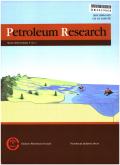Early oil charging from Sinian shales in Ordovician carbonates of the Tabei Uplift, Tarim Basin: Evidence from biomarkers
IF 4
Q1 Earth and Planetary Sciences
引用次数: 0
Abstract
Despite over 40 years of exploration focusing on the deep to ultra-deep Ordovician carbonates as major hydrocarbon targets in the Tarim Basin, the identification of their source rocks remains elusive. Based on biomarkers, carbon and sulfur isotopes of hydrocarbons, the primary source for the Ordovician petroleum system has been attributed mainly to the lower Cambrian shales, although some oils were likely contributed from the Lower Ordovician source rocks. However, the current understanding of the evolution of the Ordovician petroleum system remains rudimentary, largely due to the complex interplay of multi-source (i.e., the widespread Precambrian shales) hydrocarbon inputs, diagenetic alterations, and tectonic processes over geological time. This study systematically investigates the molecular geochemistry of reservoir bitumen within the Ordovician carbonates from Tabei uplift, coupled with bitumen from the Sinian units at the western edge of the Tarim Basin. Our results indicate that the ion chromatography-mass spectrometry spectra and the saturated to aromatic hydrocarbons ratio of Ordovician reservoir bitumen closely resemble those of Sinian bitumen, as well as the published data of Sinian shales. This coupling linkage is revealed by cross-plots and ternary phase diagrams of various biomarker parameters, which can effectively distinguish the Sinian sources from other sources, i.e., the Lower Cambrian and Ordovician, for the Ordovician reservoir bitumen. Specifically, the ∑n-C21-/∑n-C22+, Pr/Ph, G/C31H22S, C23/C21TT ratios are effective indexes to differentiate these source rocks. By compiling the published organic geochemistry data of oils, it appears to infer that approximately 8.1% of the present-day oils produced from the Ordovician carbonates likely contain some proportion of Sinian-sourced oils. The recognition of Sinian sourced oils contributing to the paleo- and present-day Ordovician petroleum system offers valuable insights for the exploration of deep-ultra deep carbonates in the Tarim Basin, emphasizing the need to consider Precambrian shales as a significant hydrocarbon source.
塔里木盆地塔北隆起奥陶系碳酸盐岩震旦系页岩早期油气充注:来自生物标志物的证据
40多年来,塔里木盆地以深奥陶系至超深奥陶系碳酸盐岩为主要油气勘探目标,但其烃源岩的识别仍是一个谜。根据生物标志物和烃的碳硫同位素,奥陶系油气系统的主要来源主要是下寒武统页岩,但也有可能来自下奥陶统烃源岩。然而,目前对奥陶系油气系统演化的认识仍处于初级阶段,这主要是由于地质时期多源(即广泛存在的前寒武纪页岩)油气输入、成岩蚀变和构造作用的复杂相互作用。本文系统地研究了塔北隆起奥陶系碳酸盐岩储层沥青的分子地球化学特征,并结合塔里木盆地西缘震旦系单元的沥青。研究结果表明,奥陶系储层沥青的离子色谱-质谱和饱和烃/芳烃比值与震旦系沥青和已发表的震旦系页岩资料非常相似。各种生物标志物参数的交叉图和三元相图揭示了这种耦合联系,可以有效地区分震旦系与下寒武统和奥陶系的储层沥青。其中,∑n-C21-/∑n-C22+、Pr/Ph、G/C31H22S、C23/C21TT比值是区分烃源岩的有效指标。通过对已发表的石油有机地球化学资料的整理,可以推断,现今约8.1%的奥陶系碳酸盐岩原油可能含有一定比例的震旦系原油。震旦系烃源岩对古奥陶系和现代奥陶系油气系统的贡献,为塔里木盆地深-超深碳酸盐岩勘探提供了有价值的认识,强调了将前寒武纪页岩作为重要烃源岩的必要性。
本文章由计算机程序翻译,如有差异,请以英文原文为准。
求助全文
约1分钟内获得全文
求助全文
来源期刊

Petroleum Research
Earth and Planetary Sciences-Geology
CiteScore
7.10
自引率
0.00%
发文量
90
审稿时长
35 weeks
 求助内容:
求助内容: 应助结果提醒方式:
应助结果提醒方式:


